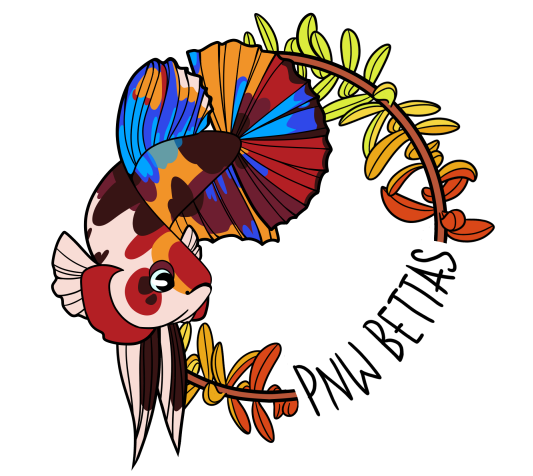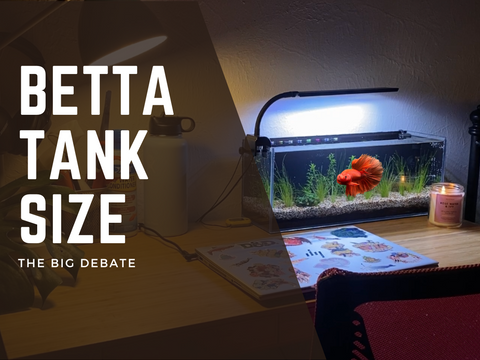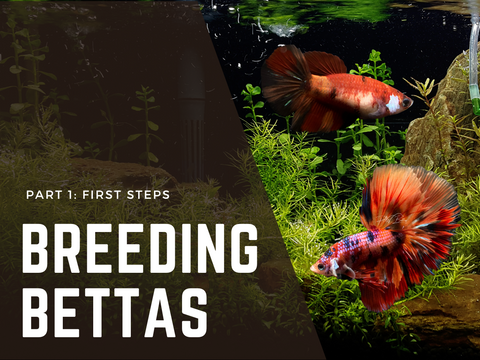A simple google search will reveal that this is a complex topic with many different opinions. Just comparing some of your results you will see a wide range of recommended tank sizes for Betta splendens, everywhere from ¼ of a gallon to 10 gallons. This is a HUGE range! How do you know what to pick? And when you reach the stage of shopping for your first betta aquarium you will find many small aquariums marketed just for bettas, this is what you should choose right?
In this post I will break down the details when it comes to betta tank size, and explain in depth my reasoning for my recommendation, and really get into the question “but why?”. I think a nuanced question like this that polarizes so many in this hobby really deserves an in-depth answer.
My Experience
So who am I when it comes to this topic? Besides owning and running PNW Bettas, I also am a breeder, a hobbyist, and a biologist. I have had years of experience with these fish, and I have seen the results of how they are housed. But I think being a breeder is what really opened my eyes to the nuance of this topic, and really helped develop my understanding of what is important for the health and wellbeing of these fish.
Bettas Natural Habitat
One common reasoning that people give to why bettas can live in small containers is “they live in puddles in the wild”. This however couldn't be further from the truth! Bettas are native to areas of Southeast Asia. When you examine their natural habitats they definitely aren't puddles! They consist of densely vegetated shallow bodies of water, which are warm and low in pH due to the climate and location. While they may not be large open ponds, you can't deny that they consist of many hundreds of gallons of water.

Credit: Franks Bettas on YouTube “Catching Wild Bettas in their habitat in Thailand with underwater footage! - FranksBettas”

Credit: Franks Bettas on YouTube “Catching Wild Bettas in their habitat in Thailand with underwater footage! - FranksBettas”
Its also important to note the difference between wild populations and species from domesticated bettas. When most people think about bettas, they think of the brightly colored long finned fish, which are domesticated betta splendens. But these have never and should never be living in these habitats, they don't exist in the wild. Wild populations of betta splendens do exist, along with over 70 recognized species of bettas, but they differ in morphology. So comparing to wild habitats does have its limitations.
When looking at wild habitats to influence our keeping methods, a study done in 2000 titled “Bubble nest habitat characteristics of wild Siamese Fighting Fish” found the average territory per fish was about 11 gallons. So this whole puddle recommendation can really just be thrown out the window.
What should I be keeping my fish in then?
Now we get into my recommendations and why. Lets just get it out of the way: in general I recommend a 5+ gallon tank. But before you go telling me that's too small or too big, let me talk about why. In my experience, going from having never kept bettas before, to having over a thousand fry and mature bettas in my fish room, this is the size I always come back to for your average fish. The reasoning is: it's a good size to maintain water parameters with ease, it gives enough space for my more active fish (assuming it's a longer then taller tank), and it's not too big or expensive.
However, with so much variation in the domestic bettas nowadays, this isn't a one size fits all mold. Truly every fish is different, and sometimes you have a fish that does better in a smaller or larger tank. Some examples of this are plakats. Some really active short finned bettas, or even giant/king bettas really do best in large tanks. They really do utilize all that space and benefit from it. However on the other hand you may have a long finned dumbo that just needs to rest more often, and he may do best in a shallow 3 gallon long.
Water Quality
Now lets logic this out in terms of water quality and parameters. As a breeder and seller I obviously don't have 5 gallons tanks for every fish I sell. I would have to have hundreds of tanks! So how do I keep the fish I sell healthy? The answer is water quality! If you are newer to keeping fish this is where things start to get a bit more science-y, but stay with me! This is the most important part about keeping fish. Think about water quality to fish as air quality to humans, it's really important for health!
So what do we need to maintain and how? The main culprit to poor water quality stems from fish food and fish poop. When you fish processes its food, it also poops. This poop releases ammonia into the water once expelled from the fish. Ammonia is very toxic to fish and you do not want any concentration in your tank. We can get rid of this ammonia two ways: a huge number of water changes or having a cycled tank! Clearly one is easier than the other. A cycle establishes special bacteria called nitrifying bacteria. This processes the fish waste and prevents ammonia buildup. But at the end of this cycle is nitrate, which needs to be removed via water changes. Having a larger aquarium reduces the frequency of these water changes, hence larger tanks make it easier to control water quality! This is why I come back to that 5+ gallon mark. I find in smaller tanks the nitrate just builds up a little too fast for my liking. Larger tanks are also more stable and your bacterial colony is less likely to crash.
Now in my case of housing hundreds of fish, we do the first option: a ton of water changes. While it works, it's not sustainable long term as a fish keeper, which is why it's really only recommended as a temporary housing method. It keeps the fish healthy and well cared for before their forever homes, but you who are keeping this fish for multiple years don't want to water change 90% of the fish's water 3x a week.
Dimensions Over Volume
Another consideration is the dimension of your tank. As you saw from the wild habitat, they live in very shallow waters. Because of this, the wild fish that were used to domesticate bettas were well adapted to these habitats, and the domestic versions years later still have these adaptations. Bettas are part of the anabantiform group. This group of fish, which includes gourami, are what are called labyrinth fish. They use the surface to obtain oxygen as well as their gills. This is an adaptation that originated from living in areas with low dissolved oxygen. Because of this, access to the surface is important, and having longer, more shallow tanks is preferred. Bettas also swim back and forth, rather than up and down, and will get more out of a horizontal tank than a vertical tank. I truly believe a 3 gallon long to be better suited for a long finned betta than a tall 5 gallon.
Final Thoughts
Tank size is a complex topic, especially in a fish like bettas where no two are alike. This conversation is always evolving and changing as we learn more about the species. These are my thoughts on the topic, as well as some of the reasoning as to “why”. I hope this helps clear up some common misconceptions, and gives you a better understanding as to the needs of these fish.
Happy betta keeping!



Comments (2)
I have a UNS 30 C which I think is about 7 gallons. I do have a couple plants in it. How often would you recommend a water change?
This is the best explainer I’ve ever read on this topic. So many people say “5 gallons is ideal” without addressing the why and accommodating individual bettas’ needs. This is well thought out, beautifully explained, and is a wonderful resource for educating people on which tank size is truly best.